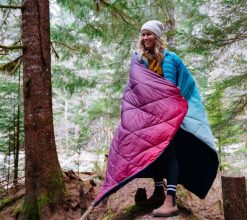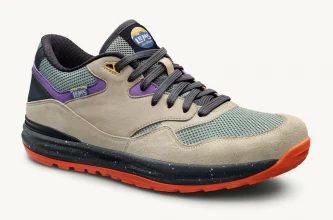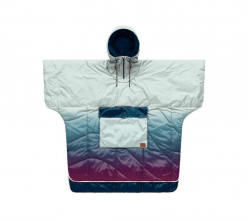As someone who likes to shop, it’s concerning to learn that the fashion industry is one of the largest contributors of waste and pollution globally. In the United States alone, 21 billion pounds of textile trash ended up in landfills in 2015, according to the US Environmental Protection Agency. In 2014, clothing purchases increased by 60% compared to 2000, but the clothes were only kept for half the time. So people are buying a lot more stuff and throwing it away faster than ever before.
As consumers, there are three primary ways that we can help address this issue of waste and pollution created by the fashion industry:
- Stop buying so much stuff. Only buy new clothing when absolutely necessary.
- Buy clothes made from recycled materials.
- Buy used, second-hand clothing.
Everybody knows how to do option number one, so we will cover options two and three in this article. We’ll also explain the advantages and disadvantages of wearing clothes made from recycled materials, and provide a list of where to shop for recycled clothing.
Article Sections:
Section 1: The problem of waste in the fashion industry
Section 2: Brands that make clothes from recycled materials
Section 3: Where to shop for second hand clothes
Section 4: FAQs

Section 1: The problem of waste in the fashion industry
Fast fashion is about all overproduction and overconsumption
The global fashion industry produces more than 100 billion garments annually, according to a 2020 report by McKinsey & Company. This surge has led to consumers buying more clothing that ever before in the history of humans.
Fast fashion is wasteful
According to the 2017 Ellen MacArthur Foundation report, at least $500 billion worth of clothing is tossed in the trash bin every year. In the US alone, the EPA estimated that 17 million tons of textile waste were generated in 2018, with only 15.2% being recycled, and the rest thrown away in the city dump.
Fast fashion depletes resources
The fashion industry uses an enormous amount natural resources like water, energy, and raw materials. For example, it takes approximately 2,700 liters of water to produce a single cotton t-shirt, as per the World Wildlife Fund (WWF).
Fast fashion is polluting and toxic
The fashion industry produces loads of toxic chemicals. In 2012, Greenpeace uncovered chemicals like nonylphenol ethoxylates (NPEs) in everyday clothing, made by popular brands like Levi Strauss and Zara. These substances can wreak havoc on the human body and the natural environment – from birth defects to cancer.
Fast fashion encourages throwaway culture
This business model built on superficiality and instant gratification encourages consumers want to consume as much as possible without thinking of the consequences. In 2019, researchers for the Journal of Cleaner Production found that fast fashion clothes have a much shorter lifespan than other more expensive, high quality clothing.
Section 2: Fashion brands that make clothes from recycled materials
Because of this explosion of trash in the US and globally, there is a growing trend in sustainable fashion to use recycled materials to make new clothing. Materials like polyethylene terephthalate (PET) plastic bottles and nylon fishing nets are particularly useful to repurpose into new fabric.
According to the Changing Markets Foundation survey of 50 fashion brands, 85% of the survey respondents have set specific goals to create recycled polyester from plastic bottles. H&M, Madewell, J Crew, and Gap Inc, have pledged to increase their usage of recycled polyester to 45% by 2025 as part of the Recycled Polyester Challenge created by a non-profit focused on promoting the use of sustainable fibers in the textile industry.
Patagonia

Patagonia is one of the largest outdoor apparel brands and uses a large number of recycled materials, including recycled cashmere, recycled nylon from fishing nets, recycled polyester, and recycled wool in hoodies, sweatshirts, and puffer jackets. In 2019, Patagonia estimated that it had saved over 86 million plastic bottles from ending up in landfills by using recycled polyester in its clothing.
What recycled materials does Patagonia use in its clothing? Recycled polyester from post-consumer plastic bottles, recycled nylon from discarded fishing nets, recycled wool from pre-consumer scraps and recycled down insulation from comforters and pillows.
What sustainability initiatives does Patagonia have?
- bluesign® certified – Products with this designation meet rigorous standards for environmental sustainability and safety throughout the manufacturing process.
- FLA Workplace Code of Conduct – Establishes guidelines for fair labor standards, safe working conditions, and environmental responsibility.
- Fair Trade USA
- Global Organic Textile Standard – Sets standards throughout the supply chain, from harvesting to manufacturing to labeling.
Outerknown

Outerknown is an athletic apparel company founded by World Surf League champion Kelly Slater and designer John Moore. The company uses recycled polyester, Econyl nylon and organic cotton to create hoodies, joggers, sweatshirts and swimwear.
What recycled materials does Outerknown use in its clothing? Econyl, a type of nylon made from recycled fishing nets and other discarded materials, recycled polyester from plastic bottles, and recycled wool.
What sustainability initiatives does Outerknown have?
- Fair Labor Association
- Fair Trade Certified – Ensures fair wages and working conditions for factory workers.
- Regenerative Organic Certified Farming Practices
Fjallraven

Fjällräven is a Swedish outdoor clothing and equipment company founded in 1960. The company’s name translates to “Arctic fox” in Swedish and is a reference to the founder’s love of nature and the outdoors. Fjällräven products are practical, durable, and designed to withstand the rigors of outdoor adventures, while also being eco-friendly and sustainable.
What recycled materials does Fjällräven use in its clothing? Eco Shell, a waterproof and breathable fabric made from recycled polyester, pre-consumer recycled wool, and G-1000 fabric made from a blend of organic cotton and recycled polyester.
What sustainability initiatives does Fjallraven have?
- bluesign® certified
- Swedish Chemicals Group Member
- Fair Labor Association
- Organic Content Standard
- Responsible Down Standard
The North Face

The North Face is an American outdoor clothing and equipment brand founded in 1966 by Douglas Tompkins and Kenneth “Hap” Klopp. The company is known for its high-quality outdoor gear, including clothing for men and women, jackets, backpacks, tents, and sleeping bags. The North Face makes clothing out of sustainable materials like Bluesign approved recycled polyester.
What recycled materials does the North Face use in its clothing? Recycled polyester, recycled nylon and recycled down insulation.
What sustainability initiatives does the North Face have?
- Fair Labor Association
- Migrant Workers Programs
- Living Wage Programs
- Responsible Down Standard
- Forest Stewardship Council, the North Face uses FSC-certified materials in many of its products, which means the materials come from responsibly managed forests.
- Higg Index, a tool that measures environmental and social sustainability across the company’s supply chain, to help guide its sustainability efforts.
Coalatree

Coalatree is a sustainable clothing company founded in 2010 to create eco-friendly, vegan clothing, including activewear, hoodies and sweatshirts. The company uses a range of sustainable fabrics, including coffee grounds. Coffee grounds has several benefits, including natural odor-fighting, moisture-wicking and quick-drying properties, making it perfect for activewear and outdoor clothing.
What recycled materials does Coalatree use in its clothing? Recycled polyester, “Coffee Fabric” made from a blend of recycled coffee grounds, organic cotton and recycled polyester.
What sustainability initiatives does Coalatree have?
- OEKO-TEX Standard 100 – Ensures that the materials used are free from harmful substances and chemicals.
Cotopaxi

Cotopaxi was founded in 2014 with the mission innovative products that make a positive impact. The company creates outdoor clothing and gear using recycled polyester to create activewear, outerwear and backpacks.
What recycled materials does Cotopaxi use in its clothing? Recycled polyester, repurposed fabrics and DownTek, a recycled down insulation made from post-consumer materials.
What sustainability initiatives does Cotopaxi have?
- B Corp., which means it has met rigorous standards for social and environmental performance, accountability, and transparency.
- Fair Trade Certified
- bluesign® certified Products
- Responsible Down Standard
- Cotopaxi is a member of 1% for the Planet, which means it donates one perfect of its annual sales to environmental causes around the world.
Plant Faced

Plant Faced is a clothing company that specializes in sustainable and vegan fashion. The brand was founded in 2018 with the mission to create high-quality clothing that is ethically made and environmentally friendly. All of Plant Faced’s clothing is made from sustainable materials and eco-friendly dyes and inks in its printing process.
What recycled materials does Plant Faced use in its clothing? Recycled polyester and recycled cotton from post-consumer plastic and textiles.
What sustainability initiatives does Plant Faced have?
- Global Organic Textile Standard (GOTS) – certification ensures that the cotton used in their clothing is organic and that their production process meets specific environmental and social criteria.
Section 3: Where to shop for second-hand clothes
The saying that “one person’s trash is another person’s treasure” never rings more true than when shopping at a used clothing store. Buying used clothing is by far one of the best and most effective ways to solve the problem of waste and pollution, because it diverts the clothes from ever entering landfills in the first place.
It’s also a reason to invest in high-quality products that will last for years and years, rather than buying cheaply made fast fashion that falls apart after a few spins in the washing machine. When you purchase a quality made product, it will last longer and you’re more likely to keep it for years and donate it once you’ve outgrown it.
Here are a few popular places to shop second hand:
Thrift stores for second-hand clothing at affordable prices:
Online marketplaces to find gently used clothes:
Consignment shops for high-end clothing:
- The RealReal designer clothing, accessories, and home decor
- ThredUp second-hand clothing
- Vestiaire Collective luxury and high-end designer clothing, accessories, and jewelry
Online vintage shops that specialize in vintage and retro clothing:
Section 4: FAQs
What are clothes made from recycled materials?
A wide range of clothing can be made from recycled materials, including hoodies, shirts, sweaters, trousers, workout gear and even shoes and blankets.
What recycled materials can be used for clothing?
Recycled plastic bottles made of polyethylene terephthalate (PET) is the most frequently used to make fabrics like polyester, called rPET. Other recycled materials used for clothing include cashmere, cotton, leather, vegetable and fruit byproduct like pineapple leaves, nylon, rubber, wool, wood fibers and even fishing nets.
Can cashmere be recycled?
Cashmere can be recycled by sorting, shredding, and spinning post-consumer yarn from old clothes that have been thrown away. Recycled cashmere is equally as warm as traditional cashmere, yet it has an 80% lower environmental impact. [2] Brands like Patagonia, Stella McCartney and Eileen Fisher use recycled cashmere in their clothing.
Can cotton be recycled?
Cotton may be recycled from old discarded clothing or textile materials. The quality of recycled cotton may not be as good as fresh cotton, thus recycled cotton is usually combined with new cotton. Recycled cotton production is still low compared to new cotton.
Can leather be recycled?
Leather can be recycled from old leather pieces that come from leather tanneries and discarded leather goods. However, many fashion brands avoid recycling leather due to the difficulties of reusing old leather. There are companies which specialize in recycling high-quality leather to make new products.
Can pineapple leaves be recycled to make clothing?
Pineapple fiber can be recycled from discarded pineapple leaves and woven into textile-grade fibers, including Piñatex® used to make vegan leather. Piñatex® is biodegradable, reduces trash, and helps Filipino pineapple producers make additional revenue. The art of pineapple fiber recycling dates back to the 19th century. [3]
Companies like H&M and Levis use recycled pineapple leaves for apparel like outerwear and footwear.
Can nylon be recycled?
Nylon can be recycled into a regenerated fabric called Econyl, created by the Italian company Aquafil. The majority of recycled nylon comes from fabric waste discarded by weaving mills and industrial fishing nets discarded in the oceans. Recycled nylon is used to make a wide variety of products, including clothing, hosiery, lingerie and swimwear.
Can rubber be recycled?
Rubber can be recycled and is usually derived from old tires at landfills. Recycled rubber can be used in a variety of applications, from yoga mats to sneaker soles.
Can spandex be recycled?
Spandex is recycled by collecting waste discarded during manufacturing processes. 4,200 tons of recycled spandex are generated each year and diverted from landfills. [4]
Can wood be recycled to make clothing?
Wood cellulose, usually from eucalyptus trees, can be converted into a cellulose fiber used to make Lyocell, also known as Tencel. Lyocell is a form of rayon and often used to make activewear and swimwear.
Can wool be recycled?
Wool can be recycled from both pre-consumer and post-consumer sources, such as factory scraps and discarded clothing. It is a natural, biodegradable textile with a broad range of applications, including clothing, blankets, and the flame retardant layer in mattresses.
Patagonia, an outdoor apparel brand, states that using recycled wool has decreased their CO2e emissions by 95% when compared to virgin wool. [5]
How is clothing made from recycled plastic?
First, water bottles are collected and processed in recycling facilities in places like Taiwan, which has a sophisticated, well-regulated recycling program. Any part of the bottle that cannot be processed, such as the cap or ring, is removed, and the bottles are sent to a machine that breaks them down.
The plastic bottles are crushed into fine flakes. Those flakes are melted into small pellets about 3mm wide. Those pellets are melted, purified, and spun into a variety of materials, including polyester yarn called rPET. The polyester yarn is used to make a variety of clothing, including t-shirts, hoodies, sweatshirts, and swimsuits.
What are advantages of clothes made from recycled materials?
Reduces waste in landfills
The most obvious benefit of using recycled materials is to remove trash from landfills. Especially plastics that don’t naturally degrade and will remain for years and years. Based on research at the Bren School of Environmental Science and Management, University of California Santa Barbara, the total amount of virgin plastic produced as of 2017 was around 8,300 million metric tons (Mt), or 18 million pounds. Of that, roughly 79% ended up in landfills.
If we keep up the current pace of plastic production and waste management, it’s projected that by 2050, the volume of plastic waste in landfills or the environment could reach 12,000 Mt, or 26 million pounds.
Everlane estimates that it has recycled over 50 million plastic bottles to make its ReNew collection, which uses recycled polyester made from plastic water bottles. The footwear company Rothy’s estimates that it has repurposed over 150 million plastic water bottles to make its shoes and bags.
Consumes less resources
- Mechanically recycled polyester ranks Class A sustainable textile and requires significantly less water and energy than virgin polyester.
- Recycled cotton is made from pre and post consumer waste and therefore uses less energy and water than conventional cotton.
- Mechanically recycled nylon also ranks as a Class A sustainable fabric and requires less water and energy than virgin nylon.
Produces less carbon emissions
In some cases, recycled materials produce less carbon emissions than traditional materials. For example, recycled polyester creates 32% less greenhouse gas emissions compared to virgin polyester.
Creates more durable fabric
Depending on the fabric, recycled materials can also be more durable. A study done in 2017 by the University of California, Davis found that recycled polyester fabrics have higher strength and abrasion resistance than virgin polyester fabrics, meaning this fabric won’t easily tear or puncture.
What are disadvantages of clothes made from recycled materials?
Releases micro-plastics into the water system
According to a study by the International Union for Conservation of Nature (IUCN), clothing made from synthetic fabrics like recycled polyester can release micro-plastics when you wash them. These micro-plastics can filter into the water system, posing risks to ocean life and entering the food chain. A 2016 study by Plymouth University found that more than 700,000 microscopic fibers could be released in a single wash cycle.
Recycled fabrics may contain toxic chemicals
Because recycled polyester is usually made from plastic bottles that contain harmful chemicals like bisphenol-A (BPA) and phthalates, traces of these substances may remain in the final product. However, some brands remove harmful chemicals during the recycling process. You can check to see if a brand’s clothes are certified non toxic on OEKO-TEX, an organization that tests fabric for harmful substances.
Related Posts:
- 8000Kicks Biodegradable Sneakers: The Perfect Combination of Style and Sustainability
- Sustainable Product Guides
- Sustainable Blankets: The Best Blankets Made From Recycled Materials
- Sustainable Hiking Shoes Made From Recycled Materials
- 30+ Sustainable Clothing Brands for Women
- 10+ Sustainable Sweatpants Brands
Resources:
- https://www.theworldcounts.com/challenges/planet-earth/state-of-the-planet/world-waste-facts/story
- https://cfda.com/resources/materials/detail/cashmere
- https://www.textiletoday.com.bd/clothing-made-pineapple-fiber/
- https://www.spanflex.com.tw/english/fabrics/detail.php?dpid=17
- https://www.patagonia.com/our-footprint/recycled-wool.html
- https://ellenmacarthurfoundation.org/a-new-textiles-economy
- https://textileexchange.org/






